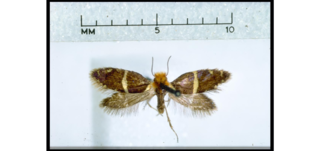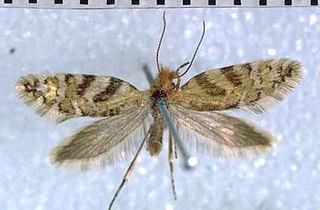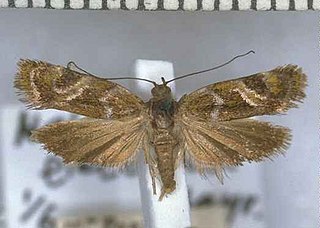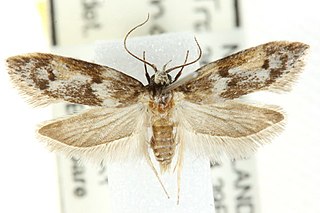
Sabatinca aurella is a species of moth of the family Micropterigidae. It is endemic to New Zealand. The larvae of this species is variable in appearance but tends to be coloured yellow-green with greyish patches. The adults of the species have a pale golden appearance with silver or purple coloured bars on the forewings. The moth has an approximate wingspan of around 1cm. This species is found from the Coromandel Peninsula to the Fox Glacier and is on the wing from September to January. A larval host species is the liverwort Heteroscyphus lingulatus. The preferred habitat of this species is at higher altitudes than other New Zealand endemic species in this genus and it tends to prefer forest or sub alpine grass or scrubland.

Sabatinca incongruella is a species of moth of the family Micropterigidae. It is endemic to New Zealand and is found only in the northern parts of the South Island. It is a day flying moth and is on the wing from mid January until late February. The larvae of this species feed on liverworts and the adult moths feed on the spores of fern species in the genus Pneumatopteris. This species can be confused with S. chalcophanes as it is very similar in appearance.

Sabatinca lucilia is a species of moth in the family Micropterigidae. It is endemic to New Zealand and is found in the top half of the North Island. The adults of this species are on the wing from the end of November until the beginning of March. The larvae of this species likely feed on foliose liverwort species with the adults likely feeding on fern spores or sedge pollen. Adults have been found on a sunny moss-covered clay bank. The species can be found in multiple forest types such as kauri, kanuka and Nothofagus and prefers to inhabit damp fern covered banks

Zealandopterix zonodoxa is a moth of the family Micropterigidae. It endemic to New Zealand and is found from the Hawkes Bay north as well as on Poor Knights, Little Barrier and Great Barrier Islands. It is the smallest micropterigid in New Zealand and the shiny white markings on the forewing of this species are variable. It is a day flying moth, but has been collected using UV light. Adults are on the wing from September to March and the species has been witnessed visiting the flowers of Nikau and Cordyline pumilio in large numbers. It inhabits a wide variety of moist indigenous forest but is associated with forests in which podocarps are common. Larvae have been sieved from rotten wood on the floor of a mixed podocarp/broadleaf forest or extracted from moss or from bryophytes.

Sabatinca is a genus of small primitive metallic moths in the family Micropterigidae. Palaeomicra and Micropardalis were both established as subgenera of Sabatinca, but were both raised to generic level by Joël Minet in 1985. However, in 2014 both these genera, Palaeomicra and Micropardalis, were recognised by George Gibbs as synonyms of Sabatinca. Extinct species in this genus are known from the Cretaceous Burmese amber.

Sabatinca doroxena is a species of moth belonging to the family Micropterigidae. It is endemic to the North Island of New Zealand. This small moth has a colourful forewing pattern with stripes and dots evident. It has been hypothesised that the forewing pattern is intended to resemble a jumping spider in order to allow the adult moth to escape predation. Adults of this species are on the wing from the beginning of September until mid January. It prefers damp but sunny habitat in deep forest, at the forest edge or in open shrubland. Larvae feed on foliose liverwort species including on Heteroscyphus normalis. Adults of this species have been located at the blossoms of flowering Cordyline and Ranunculus species.

Sabatinca ianthina is a species of moth belonging to the family Micropterigidae. It was described by Alfred Philpott in 1921. It is endemic to New Zealand. This species can be found on both the North and the South Islands from the Hawkes Bay down to Westland. The adults of this species are on the wing from the end of September until the middle of December. Although this species resembles Zealandopterix zonodoxa, S. ianthina is a larger moth and the range of the two species only overlaps in White Pine Bush Scenic Reserve in the Hawke’s Bay.

Sabatinca aemula is a species of moth belonging to the family Micropterigidae. It is endemic to New Zealand and is found in the north western parts of the South Island. The larvae of this species has yet to be collected but it has been hypothesised that the larvae subsist on foliose liverworts similar to other species in the Sabatinca genus. The adults of the species are on the wing from the middle of September until the end of December. The adults of S. aemula are very similar in appearance to S. chrysargyra and it has been argued they can only be distinguished by dissection. However more recent research suggests that the colour patterns on the forewings of the two species can be sufficient to distinguish between the two species.

Sabatinca caustica is a species of moth belonging to the family Micropterigidae. It was described by Edward Meyrick in 1912. It is endemic to New Zealand and is found in both Southland and at Stewart Island / Rakiura. The adults of this species are variable in appearance with some specimens being mainly white on their forewings while others have forewings that are a more mottled purple-brown colour. Adults are on the wing from the start of October until the middle of December. Larvae feed on the surface of leafy liverworts.

Sabatinca chrysargyra is a species of moth belonging to the family Micropterigidae. It was described by Edward Meyrick in 1886 and is endemic to New Zealand. It can be found from Franz Josef Glacier / Kā Roimata o Hine Hukatere south but only on the western side of the South Island. Adults are on the wing from the beginning of October until the middle of January. Larvae likely feed on foliose liverworts and have been found on species in the genus Plagiochila. The adult moths live in a range of habitats preferring sunny open spaces in forests or snow-tussock grasslands that can range in altitude from near sea level up to 1,230 m. This species is very similar in appearance to Sabatinca aemula and dissection of genitalia is required to distinguish between the two species.

Sabatinca demissa is a species of moth belonging to the family Micropterigidae. It is endemic to New Zealand and is found in the northern half of the North Island. The larvae of this species are small in size and are coloured pale green with darker green or black patches on the rear of its body. The adult moth is coloured yellow-brown with black dots on its forewings. It is a small moth with a wingspan of approximately 6.5 mm in length. Unlike many species of moth, it does not have a pheromone communication system. The adults of the species are on the wing from November to January. The larvae of this species feed on leafy types of liverwort. The adults of this species feed on the spores of fertile cones of Lycopodium volubile and Lycopodium scariosum.

Sabatinca heighwayi is a species of moth belonging to the family Micropterigidae. It was described by Alfred Philpott in 1927 and is endemic to New Zealand. It can be found north of Lewis Pass in the north west of the South Island. Adult moths are on the wing from late September until the middle of January. The host of the larvae of this species is the foliose liverwort Plagiochila circumcincta.

Sabatinca quadrijuga is a species of moth belonging to the family Micropterigidae. This species is endemic to New Zealand and is found in the Dunedin area and in Southland. The range of S. quadrijuga overlaps with the range of S. caustica.S. quadrijuga was first scientifically described by Edward Meyrick in 1912. As a result of its predominantly black forewings this species looks similar to a small caddisfly. The adults of this species are on the wing from September to November. Larvae feed on leafy liverwort species and the adults likely feed on fern spores or sedge pollen. The species prefers to live in well lit but damp mossy habitats. The nearest relative of S. quadrijuga is S. aurantissima.

Sabatinca aenea, also known as the Banks Peninsula Metallic, is a species of moth belonging to the family Micropterigidae. This species was first described by George Hudson in 1923. It is endemic to New Zealand and is found in Kaikōura and in the Canterbury regions. The larvae of this species is a deep grey green colour and likely feeds on foliose liverwort species. The adult moths likely feed on fern spores or sedge pollen. This species prefers moist semi-shaded habitat and the adults are on the wing from the start of October until the middle of December.

Sabatinca calliarcha is a species of moth belonging to the family Micropterigidae. It was described by Edward Meyrick in 1912. It is endemic to New Zealand. It is found in two separate areas of New Zealand - the first in the norther parts of the North Island including Great Barrier Island and the second population can be found from the top of the South Island down to Southland. The adults of the species are on the wing from the end of September until the middle of January. The species prefers to inhabit damp forests and larvae likely feed on leafy liverwort species. Adult moths likely feed on the spores of ferns or the pollen of sedge grasses.

Hierodoris electrica is a moth of the family Oecophoridae. It was described by Edward Meyrick in 1889. It is endemic to New Zealand, where it has been reported from the northern and southern parts of the South Island. The larva of H. electrica has yet to be described. The wingspan is between 15 and 16.5 mm. The ground colour of the forewings is dark brown, with narrow yellow scales overlaying this base colour. The hindwings are brown. The known larval host species is Olearia nummulariifolia.

Eudonia zophochlaena is a moth in the family Crambidae. It was described by Edward Meyrick in 1923. It is endemic to New Zealand. It has been hypothesised that this species is a North Island endemic. The adults of this species are on the wing from December until February. The larvae of this species are leaf miners of the leather-leaf fern Pyrrosia eleagnifolia.
Sabatinca bimacula is a species of moth belonging to the family Micropterigidae. This species is endemic to New Zealand and has only been found in the Percy Valley and on Secretary Island in Fiordland. This species is sexually dimorphic with the male of the species having an 'L'-shaped marking on the forewing while in the female the 'L'-shaped marking is much broader and takes up most of the half of the forewing nearest the abdomen. The adults of this species are on the wing in the second half of October. Larvae of this species feed on the liverwort Bazzania involuta. The host species of adult S. bimacula are unknown but are likely to be fern spores or pollen from Sedge grasses. As at 2017 S. bimacula has been classified as having the "At Risk, Naturally Uncommon" conservation status under the New Zealand Threat Classification System.
Sabatinca pluvialis is a species of moth belonging to the family Micropterigidae. It is endemic to New Zealand and is only known from Secretary Island. Adults of this species are on the wing from the middle of December until the middle of January. The larval host species is the liverwort Pseudomarsupidium piliferum. This species is as "Data Deficient" under the New Zealand Threat Classification System.

Trachypepla importuna is a moth of the family Oecophoridae first described by Edward Meyrick in 1927. This moth is regarded as having been introduced to New Zealand and is presumed to be native to Australia. T. importuna has been collected in both the North and South Islands of New Zealand. It inhabits native scrub and adults are on the wing in January and February. The placement of this species in the genus Trachypepla is regarded as being unsatisfactory and in need of revision.




















